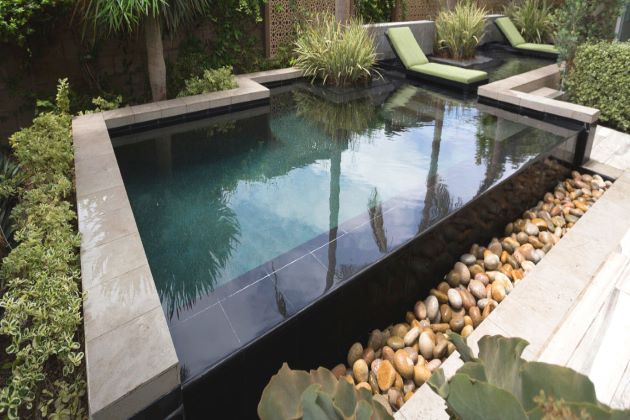So let’s dance in the rain and learn how to clear cloudy pool water, and what causes it to happen in the first place!
What Causes Cloudy Pool Water?
Have you ever noticed that the sky looks clearer and the air smells fresher after a heavy rain? This is because as the rain falls through the sky, it traps pollutants and magically makes them disappear! OK, only part of that statement is true. Rain does trap pollutants in the air, but unfortunately, it doesn’t make them disappear. Instead, the rain brings the pollutants from the air down onto the ground. What this means for your pool is that all the contaminants and pollution that were in the air are now floating in your pool water, making it cloudy. Gross.
Thankfully, this isn’t as big a problem as it may seem. Sure, your pool may not look very inviting, but clearing cloudy pool water isn’t all that hard. Keeping your pool water chemistry balanced will give you an advantage when dealing with murky water after a rain. Let’s dive in.
Storm Prep
As with most problems in life, preparation is the key to prevention. While that’s not always the case, it is a standard rule of thumb regarding pool care. Puddle-sized problems can quickly spiral into ocean-sized problems if left unattended. If you know a rainstorm is on the horizon, preparing your pool ahead of time will give you a leg-up on clearing cloudy pool water.
Test and Balance Chemicals
We know you’re a great pool owner, and never let your pool water chemistry get out of balance, right? Sure, maybe if you’re a robot! Unless you test your pool water every 5 minutes, there is no way to keep it perfectly balanced all the time. There will always be slight ebbs and flows in your pool water chemistry. Checking in with your pool’s water chemistry before a storm, and balancing the chemicals ahead of time, will save you from a major headache later.
Refer to this chart when testing your pool water. The following chemicals should be within the ideal ranges to have well-balanced pool water.
| Ideal Range | |
| Total Alkalinity | 80-100 ppm |
| pH | 7.4-7.6 ppm |
| Calcium Hardness | 200-400 ppm |
| Cyanuric Acid | 30-50 ppm |
| Chlorine | 2.0-4.0 ppm |
| Phosphates | 0 ppb |
| Total Dissolved Solids | 0-2500 ppm |
| Metals | 0 ppm |
Shock Before the Storm
As a rainstorm approaches, take some extra time to level out all pool water chemicals, and bring in the big guns. Give your pool a strong dose of shock prior to a rainstorm to add an extra layer of defense against pollutants, contaminants, and debris. Shocking your pool before a rainstorm will give it time to fight off contaminants before they take hold and cloud the water. A heavy, dirty rainstorm can deplete much, if not all, of the chlorine present in your pool water prior to the storm.
Prevent Algae Growth
In addition to shock, adding algaecide to your pool water before a storm will hinder cloudy water and algae development. While algae is a problem that can strike at anytime, it is a particularly pesky problem during the summer rainy season. Algae loves two things, water and warmth. When the warm summer sun comes out after a rainstorm, the algae in your pool will thrive. Phosphates are a main nutrient source for algae, so add a phosphate remover like PHOSfree for an extra boost against algae growth.
Trim Your Trees
If there are trees close to your pool, we suggest trimming any overhanging branches before a storm. Not only can a broken branch damage your pool equipment, but it can result in debris and contaminant build up if it falls into your pool water.
After the Storm
For minor cloudiness in your pool, we recommend using a water clarifier. Clarifiers are typically the easiest way to remove small amounts of particulates and clear up water cloudiness. Pool clarifiers work by binding small debris particles together and passing them through your pool filter. This process requires little to no work on your part, but it takes at least 48 hours for the contaminants to be fully passed through the filter and cleared out.
Using a Flocculant
If you’re dealing with intense pool cloudiness or debris buildup, using a pool flocculant is the best option. Flocculants work faster and are powerful than clarifiers, but they require more work on your part. Unlike clarifiers that pass the smaller particles clumps through your pool filter, flocculants create large clusters that sink to the bottom of your pool. You will then need to vacuum out the clusters from your pool. With your multiport valve set to waste, slowly vacuum out the clusters from the bottom of your pool. Don’t move the vacuum too quickly, or you will break up and disperse the clusters.
Clearing cloudy pool water may seem like a daunting task, but with a little patience and elbow grease, you’ll have your pool back to normal in no time. If a rainstorm is on the horizon, make sure to follow our suggested prep steps, so you can stay ahead of any problems. And when the storm passes, get your pool back in top shape with our recovery steps.
source: https://blog.intheswim.com/cloudy-pool-after-rain/




